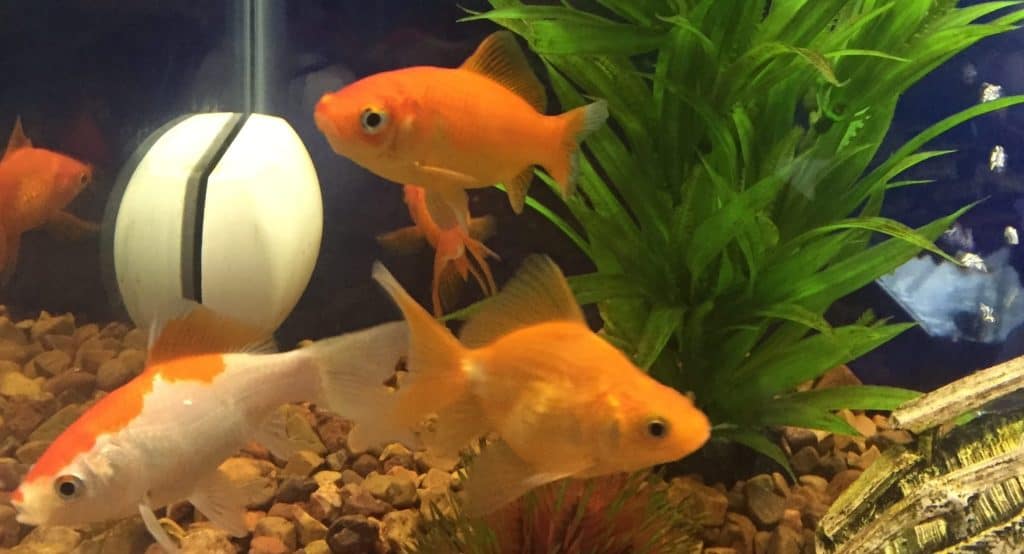One of the most common pet fish do not come with many instructions. Goldfish are not the most efficient feed to mass converters, so they tend to produce more waste than many other species. So what do you feed goldfish?
Keep in mind, it is recommended that goldfish start with 20-gallons per fish and have heavy filtration. Keep in mind that some fancy breeds with limited swimming ability should never be kept in a tank with high water flow.
Flakes vs. Pellets
Almost all goldfish diets will start with the pellet vs. flake debate. Very small fish will likely need to start with flakes, but as soon as your fish graduate to having a mouth that can handle a small pellet, it is better for their overall health. Flakes are a messy fish bowl era cliche. They start to dissolve instantly on contact with the water, foul up your water quality and don’t hold onto their nutrition as long as well as pellets.
It comes down to simple physics. Pellets have a lower surface-to-mass ratio, decreasing the amount of nutrition that can evaporate from the surface of the food. Namely, water soluble vitamins, such as Vitamin C, will stick around longer in a pellet than a flake. No matter what type you choose, most of the Vitamin C will be gone after 6 months, provided you store your fishes’ food properly.
Sinking vs. Floating Goldfish Food
Yes, both types are available on the commercial market. If they are not available in your local pet store, ask them to order you some or you can buy them online. Depending on your type of fish, how much competition there is at feeding time and the structural integrity of your fish, you may need both diets.
If your goldfish gets the floats from “constipation,” you will need to go with a sinking diet. Goldfish are physostomous fish, with a duct between their esophagus and swim bladder. Voracious surface feeding results in too much air going down the duct and an over-inflated fish. By feeding a sinking diet, you avoid the excess air. The magic green pea fix works because it is a sinking diet; it has no more fiber than regular fish food.
This can also happen in tanks with high competition at feeding time. To limit competition, spread the diet out across the surface of your tank and feed a combination of sinking and floating pellets.
How many pellets?
We know the “5-minute” rule doesn’t work well for goldfish, and how much your fish needs to eat will depend on their lifestyle. Goldfish in outdoor ponds will require significantly more energy than a fish in an indoor tank. Larger fish will need more than smaller fish. Since fish metabolism is tied to the water temperature, warmer water will mean more pellets than colder water.
The best method is to start slow and only offer 3-4 size-appropriate pellets pet fish. If your water temperature is between 65-75F (18-24C), feed once a day. Below that, every other day or every 3 days. Above 75F (24C), you will likely need to feed your fish twice a day.
How much protein?
The protein in fish food varies between manufacturers. Goldfish will do best with 30% protein for proper growth and development. Juvenile fish will require higher dietary fat and protein around 35%. If you notice your fish are growing significantly fast, check out the total protein of their food and treats combined.
Fish with swimming disabilities will require a higher calorie diet. Fancy goldfish with permanent negative buoyancy disorders will require sinking pellets in order to stay in good body condition.
Why should I soak my goldfish food?
You don’t. Soaking goldfish food is a waste of time and vitamins. Your fish are more than capable of digesting their food. If you are really concerned, feed your fish a smaller size pellet. They will be saturated within the fish’s mouth/gastrointestinal tract and your fish will receive better nutrition.
Can I feed my goldfish treats?
You can give your goldfish treats, just as long as it is ONLY ONCE A WEEK in temperatures ABOVE 65F (18C). These can include frozen meaty products, carbohydrate-rich fruits and others. Avoid the treats that look like human cheese puffs. If you must give your fish more frequent treats, go with low-calories green peas.
Our Favorite Goldfish Food
Here is our top recommendation for goldfish food for maintenance diet: OmegaOne Goldfish Pellets


Pingback: White Stringy Poop in Fish - Aquatic Veterinary Services
It is a great
Im giving to my fancy goldfish hikari lionhead and saki, tetra gold japan all mixed once per day ..on wednesday i give them bloodworms and on saturday some boiled peas without skin..sunday nothing…what you think of this?? I have 4 orandas,1 blackmoor ,1 ranchu…any advice pls? I want them To grow big and their full adult size..and i ordered a snowhite oranda…i have a 343 lts tank(us 90 gallons)…any advice pls??…i will not stock anymore…i have 2 external filters 1 eheim 2226 and 1 dolphin c-1000 filters and i do 2 waterchanges 50% per wwek…my tank is situated outside…any ad vice pls??
If you are concerned about your fish, please call (831) 278-1081 for veterinary assistance. If you are outside California and Nevada, please visit https://fishvets.org or https://wavma.org
Pingback: Are Flakes Good For Goldfish – GlobeAqua
Pingback: Can I Overfeed My Goldfish – GlobeAqua
Hi , what is a good crude ash percentage for goldfish.
Cheers
Darryl Breckell
Goldfish, like many other fish, don’t take in much mineral from their food, but rather, their surrounding water. Ash is not a requirement on fish foods, so giving a set number is hard to quantify. What is included in a diet may be comparable to water minerals or additional trace minerals, neither of which is specified.
Pingback: Can Fish Eat Carrots? (Yes & How Much)
Pingback: Which Is Better For Goldfish: Flakes Or Pellets?
Pingback: Are Fish Flakes Bad for Goldfish? Your Goldfish Diet Guide